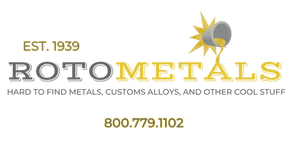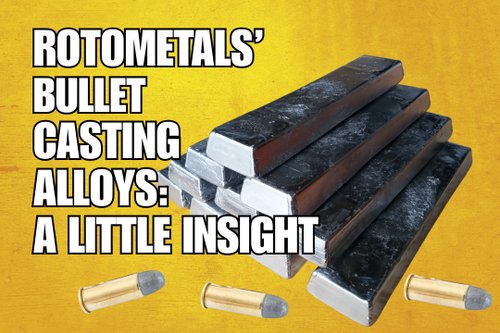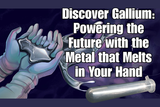RotoMetals' Bullet Casting Alloys - A Little Insight
When it comes to bullet casting, the choice of alloy plays a critical role in determining performance, accuracy, and safety. Each alloy offers a unique balance of hardness, castability, and expansion characteristics, making it essential for shooters and reloaders to understand the differences. RotoMetals, a trusted supplier in the casting community, offers a wide range of alloys tailored to various shooting applications. Among the most popular are Lyman #2, Linotype, Hardball, SuperHard, and traditional blends like 1 to 20. These alloys differ not only in their composition but also in their Brinell Hardness Number (BHN), which directly impacts how a bullet behaves under pressure and velocity.
Lyman #2 is a classic choice for general-purpose casting. Composed of 90% lead, 5% tin, and 5% antimony, it offers a BHN of around 15. This makes it ideal for moderate velocity loads in both handguns and rifles. Its balanced composition ensures good mold fill and consistent performance, making it a go-to alloy for many hobbyists and professionals alike. Linotype, on the other hand, is significantly harder, with a BHN of approximately 22. Made from 84% lead, 4% tin, and 12% antimony, Linotype is favored for high-velocity rifle bullets and precision casting. Its sharp mold fill and resistance to deformation make it perfect for applications where accuracy and detail are paramount.
Hardball alloy is another popular option, often seen as a modern alternative to Lyman #2. With 92% lead, 2% tin, and 6% antimony, it delivers a BHN of about 16. This slight increase in hardness makes it suitable for handgun bullets and moderate rifle loads, offering a good balance between expansion and penetration. SuperHard alloy, however, is not typically used on its own. Composed of 70% lead and a substantial 30% antimony, it boasts a BHN of around 30. Its primary role is as a hardening agent—ideal for mixing with softer alloys like pure lead or 1 to 20 blends to achieve a desired hardness level. This flexibility allows casters to fine-tune their bullet performance based on specific needs.
Traditional blends like 1 to 20 (95% lead, 5% tin) are softer, with a BHN of around 10. These are especially favored for black powder cartridges and applications where bullet expansion is critical. The added tin improves mold fill without significantly increasing hardness, making it a reliable choice for hunting and low-velocity rounds. RotoMetals also offers variations like 1 to 16 and 1 to 25, allowing for subtle adjustments in hardness and performance. For those seeking non-toxic alternatives, RotoMetals provides a lead-free alloy made primarily of bismuth and tin. While slightly more brittle than traditional lead alloys, it meets environmental regulations and is suitable for hunting in restricted areas.
Beyond these standard offerings, RotoMetals supplies antimonial lead blends ranging from 2% to 6% antimony. These alloys serve as customizable bases for casters who prefer to mix their own ratios. Foundry Type alloy, with its extreme hardness and high antimony content, is another specialty option for advanced applications. The ability to mix and match these alloys gives reloaders the freedom to tailor their bullets to specific firearms, game types, and shooting conditions.
Choosing the right alloy depends on several factors, including bullet velocity, desired expansion, and mold complexity. Higher BHN alloys like Linotype and SuperHard are best for high-speed rounds and precision casting, while softer blends like 1 to 20 offer better expansion and are ideal for hunting. Tin content improves mold fill and casting detail, which is crucial for bullets with intricate designs. Due to so many variables and intricacies, RotoMetals can NOT make specific recommendations. Ultimately, we are not experts in firearms and ammunition. It would be irresponsible of us to make any such suggestions. But we can say that understanding the properties of each alloy allows casters to make informed decisions, ensuring optimal performance and safety. We highly recommend visiting the Cast Boolits forum as there are folks there daily that are sharing their knowledge and experience working with different alloys. They would have a far better grasp on the intricacies of the various alloys and their implementation for bullet casting. You can visit them at this link: https://castboolits.gunloads.com/forumdisplay.php?f=36
RotoMetals’ diverse alloy lineup empowers bullet casters to experiment and refine their craft. Whether you're casting for competition, hunting, or historical reenactment, the right alloy can make all the difference. With options ranging from pure lead to complex antimony-tin blends, RotoMetals provides the tools needed to achieve consistent, high-quality results. By mastering the nuances of each alloy, casters can elevate their performance and enjoy a more rewarding shooting experience.
Recent Posts
-
Antimony in Focus: Properties, Applications, and Global Market Shifts
Antimony is a metalloid with a long history and a modern strategic edge. With the symbol Sb and atom …Nov 19th 2025 -
The New GOLD?! Germanium: The Strategic Rare Earth Metal Shaping the Future of Technology
Germanium is a rare metalloid that has quietly risen from scientific curiosity to strategic necessit …Nov 19th 2025 -
Discover Gallium: Powering the Future with the Metal that Melts in Your Hand
Gallium is a scientific curiosity turned strategic cornerstone. With a melting point of about 85.6°F …Nov 19th 2025




